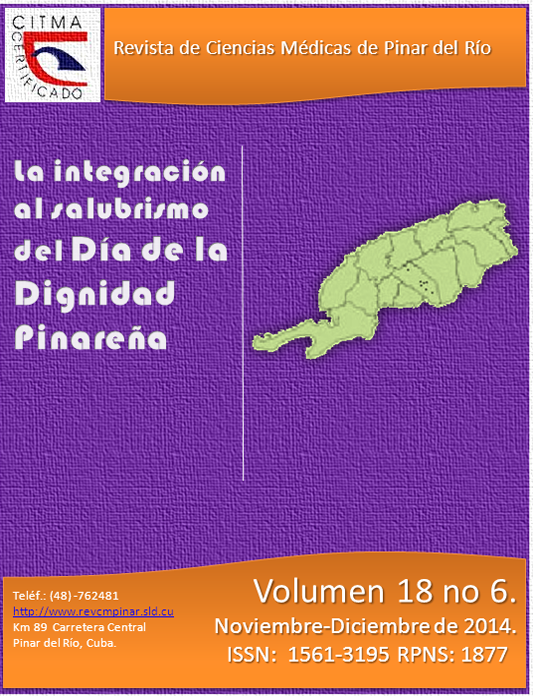Rhabdomyolysis caused by propofol leads to acute renal failure
Keywords:
Rhabdomyolysis/complications, Renal insufficiency/therapy, Propofol.Abstract
Introduction: One of the most feared complications of rhabdomyolysis is acute renal failure. Renal injury is caused by acute tubular necrosis resulting from myoglobinuria. It usually begins to improve within 15 days, although it can also lead to death or last longer. A wide variety of sedatives are currently available in intensive care, including propofol. In propofol infusion syndrome, its pathophysiology is still unknown; it is characterized by heart failure, rhabdomyolysis, metabolic acidosis and acute renal failure. In critical care, acute renal failure is a frequent condition in the context of multiple conditions; however, it is infrequently related to the use of sedatives.
Case presentation: this was a patient admitted to the Intensive Care Unit for severe pneumonia, requiring invasive mechanical ventilation. He developed acute renal failure due to rhabdomyolysis, secondary to the use of propofol. He received treatment with renal replacement therapy and full recovery at discharge.
Conclusions: the case presented shows rhabdomyolysis as a cause of acute renal failure, which is not always acute renal failure, not always prevented, from the presence of myoglobinuria in urine, blood and themyoglobinuria in urine, blood and the elevation of enzymes (creatine kinase, lactate dehydrogenase),
lactate dehydrogenase). The use of propofol implies not to pass the patched doses, and rhabdomyolysis should be recognized among its possible adverse effects.
Downloads
References
1. Montero J, Lovesio C, et al. Rabdomiólisis por spinning en nueve pacientes. MEDICINA (Buenos Aires) [Internet] 2009 [citado 2014 febrero 16]; 69: 153-156 Disponible en: http://www.clinica-unr.com.ar/Publicaciones/26/26_Rabdomiólisis%20por%20spinning.htm
2. Huerta-Aldin AL, Varon J, Marik PE. Bench-to-bedsidereview: rhabdomyolysis-an overview for clinicians. Critical Care [Internet] 2005 [citado 2014 May 25]; 9: 158-69. Disponible en: http://www.ncbi.nlm.nih.gov/pmc/articles/PMC1175909/
3. Rostagno A, Ghiso J. Análisis bioquímico de mioglobinuria asociada con rabdomiólisis. Acta Bioquím Clín Latinoam [Internet] 2013 [citado 2014 febrero 16]; 47 (1): 15. Disponible en: http://www.redalyc.org/articulo.oa?id=53526207010
4. Boutaud O, Roberts JL. Mechanism-Based Therapeutic Approaches to Rhabdomyolysis-Induced Renal Failure. Free Radic Biol Med. 2011 September 1; 51(5): p.1062-1067.
5. El-Abdellati et al. An observational study on rhabdomyolysis in the intensive care unit. Exploring its risk factors and main complication: acute kidney injury Annals of Intensive Care [Internet] 2013, [citado 2014 febrero 16]; 3:8 Disponible en: http://www.annalsofintensivecare.com/content/3/1/8
6. Türk Hacer ?ebnem, Aydo?mu? Meltem, Ünsal Oya, Köksal Hakan Mustafa, Açik Mehmet Eren, Oba Sibel. Sedação e analgesia em colonoscopia eletiva: propofol-fentanil versus propofol-alfentanil. Rev. Bras. Anestesiol. [serial on the Internet] 2013 Aug [cited 2014 May 25] ; 63( 4 ): 353-358. Disponible en: http://www.scielo.br/scielo.php?script=sci_arttext&pid=S0034-70942013000400008&lng=en
7. Cremer OL, Moons KGM, Bouman EAC, Kruijswijk JE, de Smet AM, Kalkman CJ. Long-term propofol infusion and cardiac failure in adult head-injured patients. Lancet. [Internet] 2001 [citado 2014 enero 22]; 357(9250):p.117-8.
8. Shudong Fang, MD, Hui Xu, et al. Continuous Veno-Venous Hemofiltration for Massive Rhabdomyolysis After Malignant Hyperthermia: Report of 2 Cases. Anesth Prog [Internet]. 2013 [citado 2014 May 25]; 60(1):p.21-24. Disponible en: http://www.ncbi.nlm.nih.gov/pmc/articles/PMC3601726/
9. Almeida da Silva SH, Almeida CS, Mendes Brandão JC, Nogueira e Silva CA, Pinto de Lorenzo ME et al. Hipertermia maligna no Brasil: análise da atividade do hotline em 2009. Rev. Bras. Anestesiol. [Internet] 2013 Feb [citado 2014 May 25]; 63(1): p.20-26. Available from: http://www.scielo.br/scielo.php?script=sci_arttext&pid=S0034-70942013000100002&lng=en
10. Repizo Liliany P., Malheiros Denise M., Yu Luis, Barros Rui T., Burdmann Emmanuel A. Biopsy proven acute tubular necrosis due to rhabdomyolysis in a dengue fever patient: a case report and review of literature. Rev. Inst. Med. trop. S. Paulo [Internet] 2014 Feb [citado 2014 May 25]; 56( 1 ): p.85-88. Disponible en: http://www.scielo.br/scielo.php?script=sci_arttext&pid=S0036-46652014000100085&lng=en
Published
How to Cite
Issue
Section
License
Authors who have publications with this journal agree to the following terms: Authors will retain their copyrights and grant the journal the right of first publication of their work, which will be publication of their work, which will be simultaneously subject to the Creative Commons Attribution License (CC-BY-NC 4.0) that allows third parties to share the work as long as its author and first publication in this journal are indicated.
Authors may adopt other non-exclusive license agreements for distribution of the published version of the work (e.g.: deposit it in an institutional telematic archive or publish it in a volume). Likewise, and according to the recommendations of the Medical Sciences Editorial (ECIMED), authors must declare in each article their contribution according to the CRediT taxonomy (contributor roles). This taxonomy includes 14 roles, which can be used to represent the tasks typically performed by contributors in scientific academic production. It should be consulted in monograph) whenever initial publication in this journal is indicated. Authors are allowed and encouraged to disseminate their work through the Internet (e.g., in institutional telematic archives or on their web page) before and during the submission process, which may produce interesting exchanges and increase citations of the published work. (See The effect of open access). https://casrai.org/credit/



